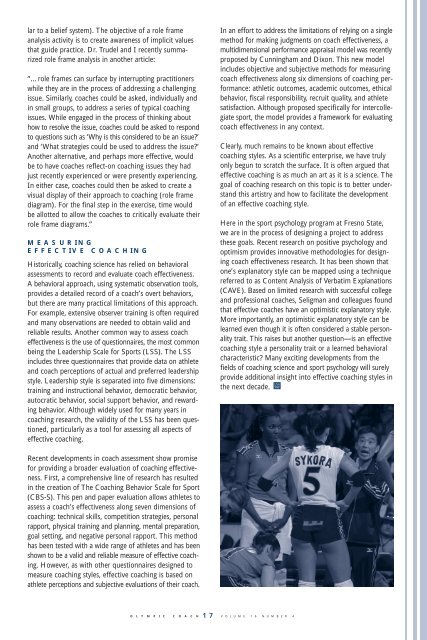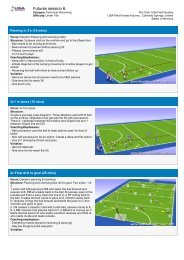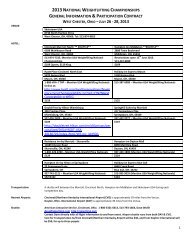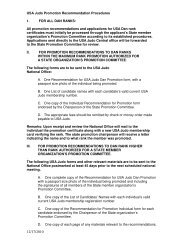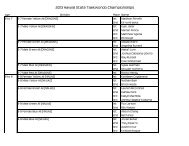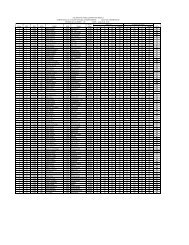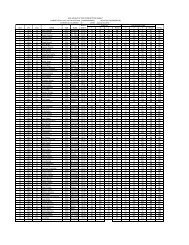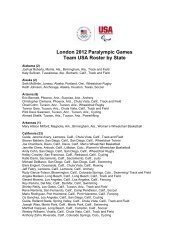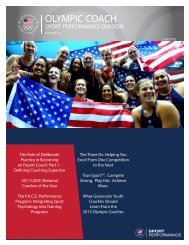OLYMPIC COACH - United States Olympic Committee
OLYMPIC COACH - United States Olympic Committee
OLYMPIC COACH - United States Olympic Committee
You also want an ePaper? Increase the reach of your titles
YUMPU automatically turns print PDFs into web optimized ePapers that Google loves.
lar to a belief system). The objective of a role frame<br />
analysis activity is to create awareness of implicit values<br />
that guide practice. Dr. Trudel and I recently summarized<br />
role frame analysis in another article:<br />
“…role frames can surface by interrupting practitioners<br />
while they are in the process of addressing a challenging<br />
issue. Similarly, coaches could be asked, individually and<br />
in small groups, to address a series of typical coaching<br />
issues. While engaged in the process of thinking about<br />
how to resolve the issue, coaches could be asked to respond<br />
to questions such as ‘Why is this considered to be an issue?’<br />
and ‘What strategies could be used to address the issue?’<br />
Another alternative, and perhaps more effective, would<br />
be to have coaches reflect-on coaching issues they had<br />
just recently experienced or were presently experiencing.<br />
In either case, coaches could then be asked to create a<br />
visual display of their approach to coaching (role frame<br />
diagram). For the final step in the exercise, time would<br />
be allotted to allow the coaches to critically evaluate their<br />
role frame diagrams.”<br />
MEASURING<br />
EFFECTIVE <strong>COACH</strong>ING<br />
Historically, coaching science has relied on behavioral<br />
assessments to record and evaluate coach effectiveness.<br />
A behavioral approach, using systematic observation tools,<br />
provides a detailed record of a coach’s overt behaviors,<br />
but there are many practical limitations of this approach.<br />
For example, extensive observer training is often required<br />
and many observations are needed to obtain valid and<br />
reliable results. Another common way to assess coach<br />
effectiveness is the use of questionnaires, the most common<br />
being the Leadership Scale for Sports (LSS). The LSS<br />
includes three questionnaires that provide data on athlete<br />
and coach perceptions of actual and preferred leadership<br />
style. Leadership style is separated into five dimensions:<br />
training and instructional behavior, democratic behavior,<br />
autocratic behavior, social support behavior, and rewarding<br />
behavior. Although widely used for many years in<br />
coaching research, the validity of the LSS has been questioned,<br />
particularly as a tool for assessing all aspects of<br />
effective coaching.<br />
Recent developments in coach assessment show promise<br />
for providing a broader evaluation of coaching effectiveness.<br />
First, a comprehensive line of research has resulted<br />
in the creation of The Coaching Behavior Scale for Sport<br />
(CBS-S). This pen and paper evaluation allows athletes to<br />
assess a coach’s effectiveness along seven dimensions of<br />
coaching: technical skills, competition strategies, personal<br />
rapport, physical training and planning, mental preparation,<br />
goal setting, and negative personal rapport. This method<br />
has been tested with a wide range of athletes and has been<br />
shown to be a valid and reliable measure of effective coaching.<br />
However, as with other questionnaires designed to<br />
measure coaching styles, effective coaching is based on<br />
athlete perceptions and subjective evaluations of their coach.<br />
O L Y M P I C C O A C H17<br />
In an effort to address the limitations of relying on a single<br />
method for making judgments on coach effectiveness, a<br />
multidimensional performance appraisal model was recently<br />
proposed by Cunningham and Dixon. This new model<br />
includes objective and subjective methods for measuring<br />
coach effectiveness along six dimensions of coaching performance:<br />
athletic outcomes, academic outcomes, ethical<br />
behavior, fiscal responsibility, recruit quality, and athlete<br />
satisfaction. Although proposed specifically for intercollegiate<br />
sport, the model provides a framework for evaluating<br />
coach effectiveness in any context.<br />
Clearly, much remains to be known about effective<br />
coaching styles. As a scientific enterprise, we have truly<br />
only begun to scratch the surface. It is often argued that<br />
effective coaching is as much an art as it is a science. The<br />
goal of coaching research on this topic is to better understand<br />
this artistry and how to facilitate the development<br />
of an effective coaching style.<br />
Here in the sport psychology program at Fresno State,<br />
we are in the process of designing a project to address<br />
these goals. Recent research on positive psychology and<br />
optimism provides innovative methodologies for designing<br />
coach effectiveness research. It has been shown that<br />
one’s explanatory style can be mapped using a technique<br />
referred to as Content Analysis of Verbatim Explanations<br />
(CAVE). Based on limited research with successful college<br />
and professional coaches, Seligman and colleagues found<br />
that effective coaches have an optimistic explanatory style.<br />
More importantly, an optimistic explanatory style can be<br />
learned even though it is often considered a stable personality<br />
trait. This raises but another question—is an effective<br />
coaching style a personality trait or a learned behavioral<br />
characteristic? Many exciting developments from the<br />
fields of coaching science and sport psychology will surely<br />
provide additional insight into effective coaching styles in<br />
the next decade.<br />
VOLUME 16 NUMBER 4


